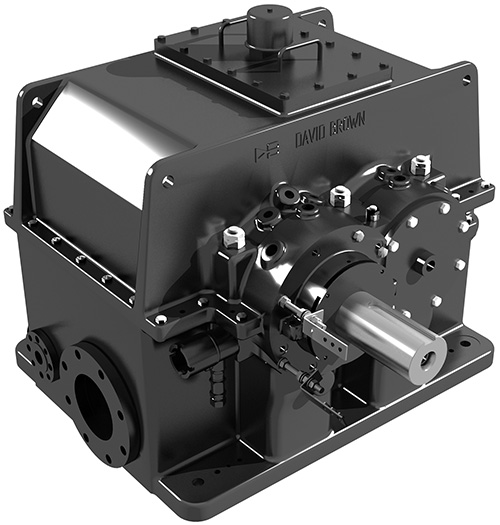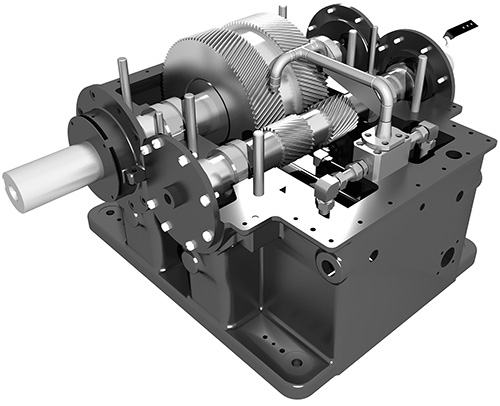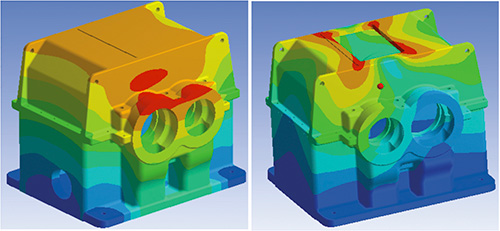The oil and gas industry has little margin for error. It fuels nearly every other industry in the world, from agriculture to information technology. Worldwide energy consumption is steadily increasing, boosted by the developing world—particularly China and India. It heats our homes, powers our vehicles and serves as a key ingredient in paints, detergents and clothing.
The world’s dependence on oil and gas tends to complicate this otherwise straightforward industry. Because it is critical to the global economy, the industry is subject to intense scrutiny by governments, regulatory bodies, investors and average citizens. The eyes of the world are fixed on this trillion dollar market, and because of this, the industry has little margin for error and even less for inefficiency.

High-speed gearboxes have to comply with strict industry standards, such as API 613
Improved refining and manufacturing efficiency is one of the industry-wide imperatives that most stakeholders agree is crucial to building a smarter oil and gas industry for the future—one that can continue to meet the challenges of one of the world’s most highly regulated operating environments head-on while also driving innovation.
In response to the demand for gears capable of higher power levels, faster speeds and better efficiencies, high- speed gearboxes have evolved through proven application to become the default choice for the oil and gas industry. As the name suggests, they run at high power and high speed in critical process applications, powering mechanisms such as pumps, compressors and generators.
.jpg)
A high-speed gearbox ready for delivery to a pump original equipment manufacturer
When Gearboxes Fail
Gearbox failures can have catastrophic implications. Of course, the degree of the effects depends on where the gearbox is and what role it plays. Oil rigs usually have a back-up system or another gearbox that can be brought online while the original is repaired. However, under certain circumstances, operators can lose production time.
Equipment shutdown leads to expensive downtime, which can be commercially disastrous and debilitating to operations. For example, if the failing gearbox is used to generate electricity, as is routinely the case at oil rigs or in refineries and gas processing plants, operators often produce an excessive volume of power and routinely sell the surplus to the grid. If the operator is suddenly unable to produce electricity at normal levels, revenue is hit two-fold. The operator must purchase electricity, and no surplus is available to sell. The financial impact can be devastating. Adjoining equipment can also be damaged by gear unit failure—misalignment by just thousandths of an inch can cause problems to develop, including high noise and vibration.
Oil leakage is a common problem because high-speed gearbox seals are non-contacting. These labyrinth arrangements are designed to minimize oil escaping the gearbox via a series of shaft flingers, baffles and walls. The oil drains back into the case.

Gear teeth are designed for accuracy to ensure compliance with industry noise and vibration specifications.
Unfortunately, because of the high speed of the gears, lubricating oil exiting the bearings near the seals has a tendency to be a mixture of liquid and vapor, and the close proximity of coupling hubs to seals causes low pressure vortices on the outside of the seal which suck the oil out of the gear unit. Moving the hubs farther away increases critical speed problems.
Beyond operational implications, gear unit failure is also a major safety risk that can result in personal injury from heat, noise, impact, fire or even explosion. Poorly selected, manufactured or assembled bearings, for example, may not generate a sufficient oil film on which the gear shaft journals can ride. This means temperatures increase, and whatever oil film is present is lost. This leads to metal-to-metal contact between the gears and the bearings. At speeds of up to 50,000 rpm, this can result in significant damage to bearings and gears. As the bearings begin to melt away, creating misalignment of the gears, further damage can be caused to seals, covers and the gears.
For the oil and gas industry, waste and mistakes such as these can quickly lead to bad publicity, speculative swings, legislative action and a distinct competitive disadvantage. It is an industry that should and must operate as efficiently and safely as possible.
%20(1).jpg)
A new high-speed gearbox being tested at its Gear Centre of Excellence in the U.K.
Gearboxes That Go the Distance
On the positive side, high-speed gear units have to meet exacting standards to handle the tough conditions and harsh climate that oil and gas equipment must endure. If installed correctly, problems and failures, while dramatic, are rare. Components are manufactured with high precision and endurance, and incidents of malfunction or breakdown are few and far between. Accidents do occur, but if gearboxes are properly installed by a professional engineer to the manufacturer’s guidelines, errors should be less likely to occur.
High-speed gearboxes are designed to maintain high quality performance throughout difficult operating conditions and long periods of time. They have to because they are responsible for powering critical equipment such as gas turbines, for example. A gas turbine may run for 50,000 hours (approximately five years) before a major service is due and the gearbox is inspected. Not to mention access issues. For example, one engineering firm has 26 high-speed gearboxes installed across a major oil pipeline in East Siberia, all built to endure temperatures as low as -45 C. The relationship between gears and bearings in a high-speed gearbox should ensure that virtually no wear takes place. This can be extraordinary to witness—when dimensions are examined during a service, components can still look brand new after about 30 years of operation.

Modal analysis enables one high-speed gearbox supplier to optimize gear case designs to meet strict industry noise and vibration specifications.
However, meeting tough industry standards set by organizations—such as the American Petroleum Institute (API) and American Gear Manufacturers Association (AGMA)—means that most high-speed gearbox suppliers have different ranges to satisfy different standards. Some manufacturers may be unwilling or unable to accommodate specific requirements. Even simple tweaks, such as moving piping interfaces from one side to the other to avoid running pipes around the gear unit, may come at a high price. Being able to tailor these design elements can be beneficial for operators.
For example, a few years ago one engineering group was contacted to provide an upgrade to on offshore production facility in North America. The floating production storage and offloading (FPSO) vessel needed a diesel pump replaced quickly.
Work had already begun on the pump, engine and skid system, but the existing gearbox supplier was unable to adapt its design to meet the size and positioning restraints. The engineering firm developed a specialized, bespoke gearbox for the FPSO.
Meeting customer expectations, where minimum cost and short lead times are important, while adhering to industry standards is challenging. For manufacturers, creating a standards-compliant design that offers a competitive edge and is still commercially viable is difficult.
As a result, many gearboxes are standardized systems, in which manufacturers concentrate their expertise around one area of the market. This means that in many instances, they have little or no flexibility for tailoring their designs to meet customer requirements.
A Lack of Experts
Few experts are available who specialize in high-speed gearboxes and are capable of adapting to specific task challenges and the complex projects that are often everyday occurrences in the oil and gas industry. Set-up costs for manufacturing and testing machinery are high. The test bed alone requires flat bedplates, a dedicated lubricating oil supply, condition monitoring equipment, motors and transfer units to allow configurations that test any of the speeds designed for the gear units.
Most important, experienced engineers and technicians with the know-how to set up run-and-test scenarios and the expertise to successfully resolve problems identified during testing are hard to find. A high level of specialist engineering is vital.
Typical calculations carried out by an engineer working on a high-speed gear unit include:
- Rating
- Shaft sizing
- Shaft fatigue life
- Bearing sizing
- Bearing loads
- Coupling selection
- Material selection
- Gear-to-shaft interface requirements
- Gear measurement data
- Gear manufacture data including micro-geometry corrections to optimize contact pattern/load sharing along gear teeth
- Gear alignment because of movement within the bearings and thermal growth of shafts, weights, inertias, torsional stiffness, gear noise and gear case flexure
.jpg)
A high-speed gearbox compliant with strict API 613 standards
A Customer-Led Product Evolution
After the engineering firm’s North American FPSO project was completed, it began to develop a standard range with a distinct difference. The company decided to use its oil and gas expertise to deliver the speed and efficiency that operators needed from a standard range that provided more flexibility. At the end of 2012, it had developed a core platform of high-speed gearboxes.
Several objectives were achieved with the newly developed gearboxes. These included a reduced quote time. To do that, the company standardized the parts from which the gearboxes can be built. This also reduced the lead time (just 18 weeks). The range is pre-engineered. The complete range fulfills all industry standards—including API 613, which demands 20 years of service life with at least five years of uninterrupted running without maintenance.
The company also focused on technical issues specific to high-speed gearboxes, such as noise and vibration, which are especially common with some of the specifications within the oil and gas industry. The firm’s engineers spent a long time exploring case design and modal analysis to find areas that vibrate under load. They also focused on gear manufacture—putting in lead corrections, profiling and crowning gear teeth to bring the entire range within the standard 85 decibel range without the need for an acoustic hood. As a result, the gearbox series is accurate, compliant and can be built quickly. By working on a configurable platform of parts, the engineers tried to keep the lead-time down but also offer options to retain flexibility in packaging.
The Gearbox Improvements
- Case material options to suit all environments, for specific temperature and environmental requirements
- Case design configuration accommodates customer requirements, simplifying package complexity to minimize package pipe runs
- Bearing choices to suit all application demands
- Standardized bearings and seals that are readily available when required, for a minimum lead-time
- Optimized oil flow to minimize the required oil volume
- Gear design and the high accuracies achieved through profile grinding ensures optimal tooth contact for long gear life, minimal vibration and quiet running
- Designed for minimum service life of 20 years
- Compliance with major international standards including API 613 and AGMA

